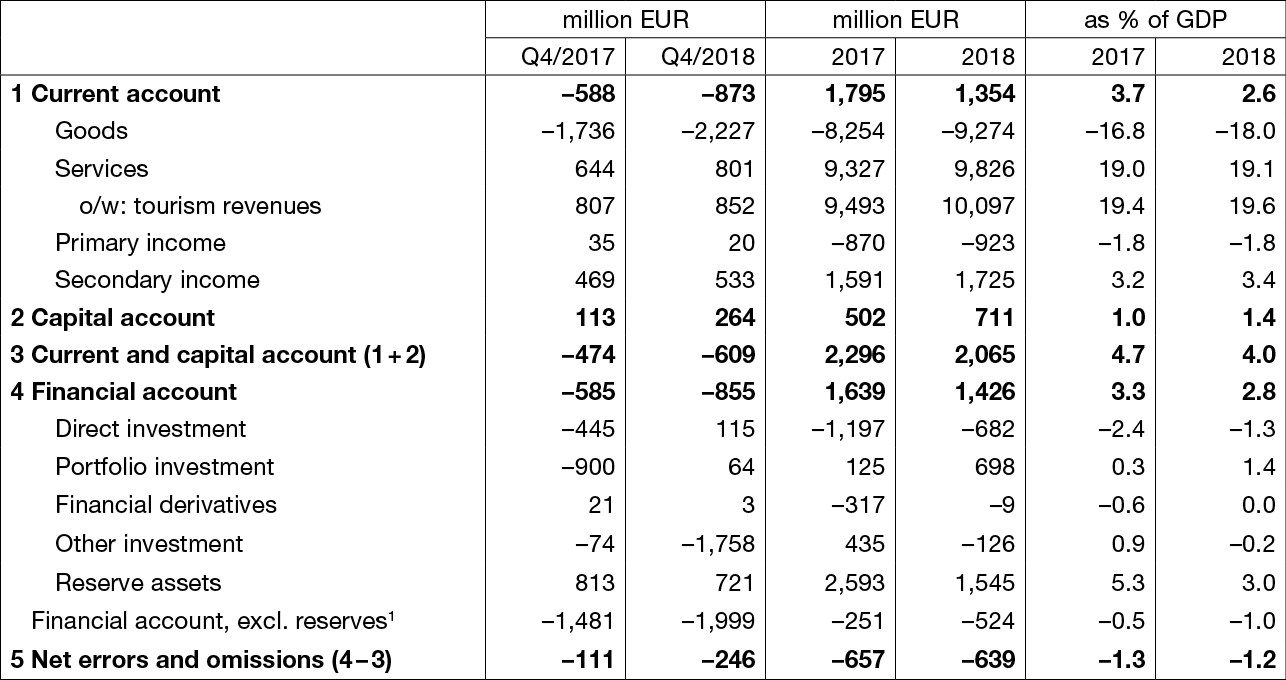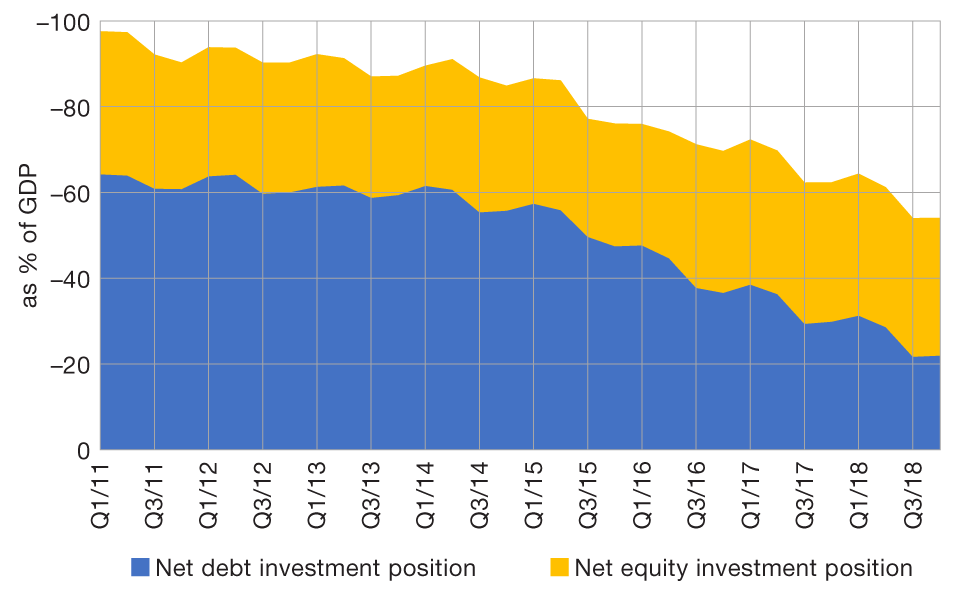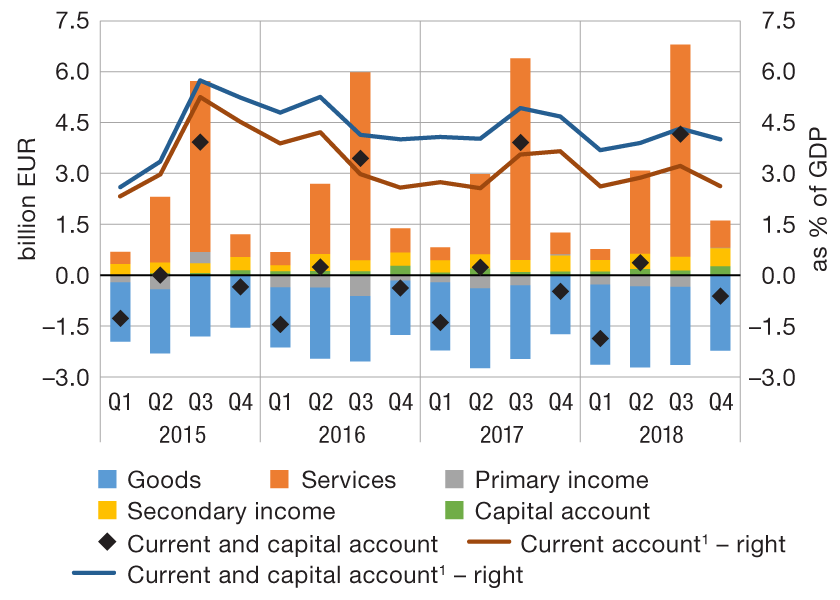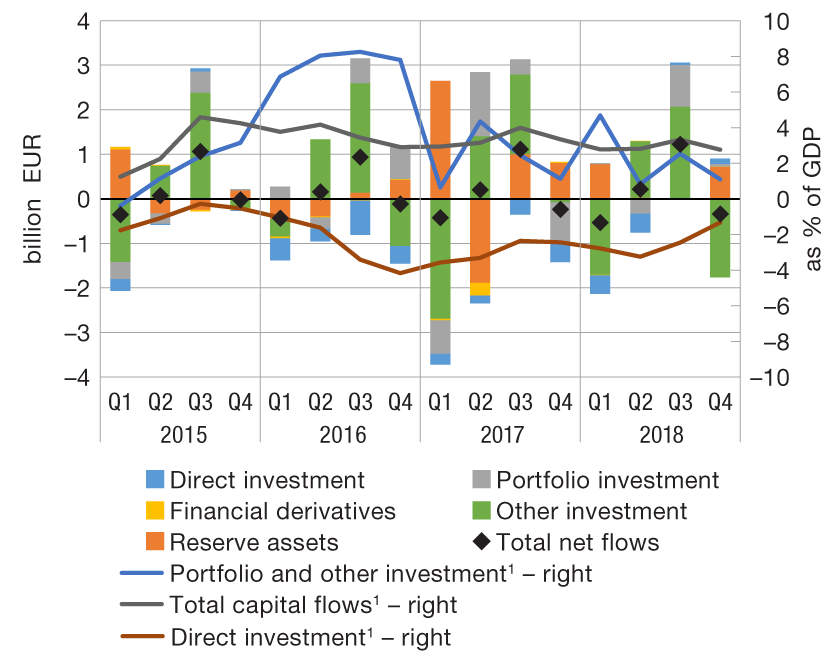From August 2023 the comments on statistics, a short description of selected, recently issued statistical data in the area of monetary statistics and the non-residents sector statistics, are no longer published. They are replaced by Statistical releases.
Comments on the balance of payments and the international investment position in 4Q 2018
The current and capital account of the balance of payments ran a deficit of EUR 0.6bn in the fourth quarter of 2018, which is an increase of EUR 0.1bn from the same period in 2017. The deterioration in the balance on an annual basis was mainly due to the sharp increase in the goods trade deficit. By contrast, unfavourable developments were mitigated by the larger surplus in the secondary income and capital account, as well as rising net exports of services, whereas a slightly positive balance was kept in the primary income account.
The last quarter of 2018 was characterised by a marked deterioration in the goods trade deficit (by EUR 0.5bn relative to the same period in 2017), with imports growing much faster than exports (11.2% versus 1.8% on an annual level). At the same time, the surplus in foreign trade in services grew noticeably (by EUR 0.2bn from the same period of the previous year), mostly on account of the rise in net exports of services in tourism, followed by research and development services and computer services.
The surplus in the secondary income and capital account grew notably (by EUR 0.2bn) between the fourth quarter of 2017 and the fourth quarter of 2018 due to larger payments from EU funds to end beneficiaries, in particular capital funds. Other revenues to the secondary income and capital account rose only marginally.
A slight positive balance in the primary income account was almost the same in the fourth quarter of 2018 as in the previous year. Expenditures on direct equity investment grew notably owing to the better business performance of domestic enterprises owned by non-residents. However, such developments were offset by larger profits of foreign enterprises owned by residents, lower interest expenditures on the external debt of domestic sectors and an increase in revenues from the compensation of residents temporarily employed abroad.
Figure 1 Balance of payments
| a) Current and capital account | b) Financial account |
|
|
|
1 The sum of the last four quarters.
Note: In the figure above showing the financial account, the positive value denotes net capital outflow abroad and the negative value denotes net capital inflow.
Source: CNB.
The financial account of the balance of payments saw a net capital inflow of EUR 0.9bn in the fourth quarter of 2018 (EUR 0.3bn more than in the same period in 2017), which was due to the net inflow to the account of other investments (of EUR 1.8bn) arising from a notable deterioration in the net foreign position of banks.[1] By contrast, a slight net outflow (of EUR 0.1bn) was recorded in the portfolio investment account, due, among other things, to the reduction in foreign liabilities of the government sector.
In the fourth quarter of 2018, a modest net capital outflow (of EUR 0.1bn) was also seen in the foreign direct investment account, mostly due to lower debt liabilities of domestic enterprises with respect to affiliated creditors. The value of debt-equity swaps was also high.[2]
International reserves grew sharply in the fourth quarter of 2018, driven by foreign exchange purchases from banks, which amounted to EUR 1.1bn. The volume of reserves invested in repo transactions[3] was reduced in the same period, so that gross international reserves grew by EUR 0.7bn.
Table 1 Balance of payments

1 Excluding the change in gross international reserves and foreign liabilities of the CNB (investment of a part of reserves in reverse repo agreements results in a simultaneous, same-amount increase in assets and liabilities of the CNB).
Note: The positive value of financial transactions denotes net capital outflow abroad and the negative value denotes net capital inflow.
Source: CNB.
As a result of the developments in the financial account, the net international investment position of the Republic of Croatia deteriorated slightly in the fourth quarter of 2018, by EUR 0.4bn, owing to the worsened net debt position of domestic sectors, in particular banks. Overall, the net international investment position stood at EUR –27.9bn at the end of the fourth quarter of 2018, or –54.1% of GDP (Figure 2).
At the level of 2018 as a whole, the current and capital account surplus accounted for 4.0% of GDP, down by 0.7 percentage points from 2017, solely due to the negative impact of value adjustments of claims on the Agrokor Group on the current profits of banks in 2017 and the related lower expenditures in the primary income account. Excluding one-off effects, the current and capital account surplus rose in 2018, mostly owing to the steady increase in net exports of services and the larger overall secondary income and capital account balance, boosted mainly by rising payments from EU funds to end beneficiaries. By contrast, the deficit in foreign trade in goods grew notably. The net capital outflow in the financial account was primarily related to the rise in international reserves and the reduction in liabilities in the portfolio investment account due to deleveraging on the part of the government. As a result, a favourable trend was seen again in the net international investment position, whose relative indicator improved by eight percentage points from the end of 2017 to the end of 2018 (Figure 2).
Figure 2 International investment position (net)

Note: The international investment position (net) equals the difference between domestic sectors' foreign assets and liabilities. Net debt investments include financial derivatives.
Source: CNB.
Data revision
Data on the balance of payments and the international investment position are revised in accordance with the commonly used practice, based on subsequently available data.
Detailed balance of payments data
Detailed data on the international investment position
In the period under review, banks sold EUR 1.1bn to the CNB, up from EUR 0.9bn in the same period in 2017. ↑
These transactions lead to an increase in equity liabilities and a parallel decrease in debt liabilities and do not affect the total change in liabilities in the foreign direct investment account. ↑
Investment of a part of international reserves in reverse repo agreements results in a simultaneous change in assets (recorded in the account of reserve assets) and liabilities (recorded in the account of other investment) of the CNB and thus has a neutral impact both on changes in the net foreign position of the central bank and the overall financial account balance. ↑


